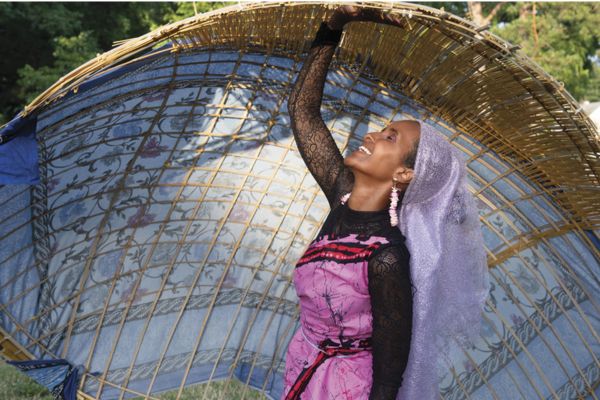
- Details
- By Ifrah Mansour for Minnesotta Women's Press
I have always been curious about building structures. I built dolls from sticks and scraps when I was a kid in a Dadaab refugee camp in Kenya.
This story first appeared at Minnesota Women's Press. Republished by Native News Online with permission.
As an alleged adult, I’m still building structures, and now they’re bigger, bolder, and will hopefully change the world.
We see the shadows of sadness everywhere in our city. The pandemic magnified brokenness. Untreated addictions and broken systems continue to smother people. We desperately need to reimagine how we see each other and care for one another. I am trying to explore this communal challenge from a place of love.
I think we heal if we build communities.
So come into the belly of the Healing Hut. A haven, woven with a million ties of love and curiosity.
The Healing Hut is an intentionally carved space, an infinite well holding our collective healing. The hut also celebrates my own personal journey of being part of a diaspora, yearning to connect more deeply with my own culture.
I am forever grateful to the elders who built a hut installation at the Somali Museum of Minnesota. Volunteering to help them gave me a passion for weaving and building indigenous structures.
Somali weaving often utilizes finger techniques to create large, intricate, gorgeous mats. The hut, called an Aqal, is a dome-like dwelling invented by our nomadic ancestors. The beauty of the Somali Aqal is that everything is from nature — the mats are made from collected fibers, the rope is made from tree bark.
This indigenous way of building became a lifeline during the Somali Civil War as people found themselves in the middle of the desert in need of shelter. People used what they could find around them to cover their huts, including old or torn clothes.
I have had the pleasure of building Healing Huts with the help of many friends. There are millions of ties and a bazillion weavings.
When we first built the hut as part of the Northern Lights Festival at Cedar-Riverside in Minneapolis, I didn’t know where to find the right materials. Thanks to the generosity of the Mississippi, we harvested sticks on the riverbanks and made a wonderful hut with the help of elders.
The second time I organized a Somali hut building was at the Cedar Cultural Center’s plaza, to create a more welcoming space for the youth in the neighborhood. Again, we gathered sticks and gave the youth an opportunity to build, while the elders gently, and sometimes harshly, offered advice from the sidelines.
In August, we will exhibit another iteration of the Healing Hut at Cedar-Riverside.
When people go inside the hut, some have said that they feel cocooned. Some feel cool and have an instant need to sit down, adjust their posture. Some have said that being inside the hut is like being in a warm hug. The softness of the woven wood entices your hands to touch it. As people sit down, I can see their heads turning, following the weaving. If I am in the hut, I ask a question that people may never have been asked before: What heals you, what brings you healing, and where do you need healing?
Vocalizing the need to reimagine how we heal is how we stay in communities.
The Healing Hut engages people from a place of fullness, from a place of strength, from a place of resilience. We can heal by building relationships that nurture caring communities.
Cedar-Riverside feeds my heart. When my family moved to Minnesota, it was the first place that welcomed me as a teenager. When I went to college, I circled back to Cedar- Riverside to volunteer to teach English to elders in the Brian Coyle Center. Mixed Blood Theatre is where I found my artistic passion. Cedar-Riverside has a generous energy that is hard to describe. People effortlessly adopt you as their own and watch out for you like the old ways.
See the Healing Hut with Ifrah Mansour on August 5, 20, and 21 at Currie Park in Minneapolis as part of Mixed Blood Theatre’s 12×12, Communities x Artists series. With support from Springboard for the Arts, this particular hut was woven from 12-foot bamboo sticks inside Judson Memorial Baptist Church, with the help of churchgoers. It will be a space for the community to reflect on their shared history.
Help us defend tribal sovereignty.
At Native News Online, our mission is rooted in telling the stories that strengthen sovereignty and uplift Indigenous voices — not just at year’s end, but every single day.
Because of your generosity last year, we were able to keep our reporters on the ground in tribal communities, at national gatherings and in the halls of Congress — covering the issues that matter most to Indian Country: sovereignty, culture, education, health and economic opportunity.
That support sustained us through a tough year in 2025. Now, as we look to the year ahead, we need your help right now to ensure warrior journalism remains strong — reporting that defends tribal sovereignty, amplifies Native truth, and holds power accountable.
 The stakes couldn't be higher. Your support keeps Native voices heard, Native stories told and Native sovereignty defended.
The stakes couldn't be higher. Your support keeps Native voices heard, Native stories told and Native sovereignty defended.
Stand with Warrior Journalism today.
Levi Rickert (Potawatomi), Editor & Publisher

